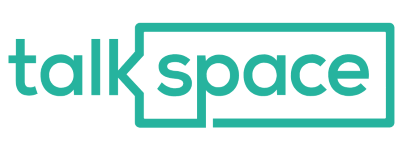Table of Contents
Finding an affordable online therapy provider can be challenging. While insurance can help cover the cost, few platforms accept it, leading many people to forego necessary mental health care due to the added financial stress of paying out of pocket. In our November 2023 survey of 600 online therapy users, 31 percent of respondents stopped using online therapy because their insurance didn’t cover it.
Talkspace is one of the few online therapy platforms that provides therapy and psychiatric care and accepts insurance. We tested Talkspace ourselves to discover its benefits and drawbacks so you can make the best choice for your financial and mental health.
Why HelpGuide cares about access to timely, affordable mental health care
Your mental health influences how you think, feel, and act in daily life. It also impacts your physical health as well as your ability to overcome challenges and setbacks, cope with stress, and build relationships.
You don’t have to be dealing with a diagnosed mental health problem, such as depression or anxiety, to benefit from mental health care. If you’re going through a difficult time in your life, such as a bereavement, unemployment, or relationship problems, support from a mental health professional can help. Even if you’re facing everyday concerns like overwhelming stress, low self-esteem, or trouble sleeping, the right care can help you make positive changes in your life. In many situations, online therapy or telepsychiatry can be an effective, convenient solution.
Current evidence suggests that for many people online therapy can be just as effective as in-person therapy. Talking from the security of your own home may even make it easier for you to open up about your problems. Online therapy also enables you to communicate with a qualified specialist remotely, while avoiding the expense, travel time, and inconvenience of having to meet in-person.
Ultimately, how well online therapy works often depends on the same factors that determine the success of any type of therapy: the level of connection you make with your therapist, how much you’re able to open up, and the work you’re willing to put into the process.
Finding the right therapist online can take some time and effort, so don’t be afraid to ask questions, read reviews, and take advantage of any introductory sessions. An online therapist will become your partner in healing, recovery, and growth so it’s important to choose someone who makes you feel understood, supported, and cared about. You need to trust this person enough to talk comfortably about intimate and often difficult subjects, and to be honest about what you’re thinking and feeling.
Of course, there can be some drawbacks to online therapy as well. While connecting via text or messaging app, for example, may be a comfortable way of communicating, the lack of face-to-face interaction robs the therapist of gauging your all-important body language and tone of voice. It can also make it harder to build trust and a supportive rapport between you and the therapist, which can be crucial to the success of therapy. That can usually only be achieved in-person or via a live video link.
With online therapy, you’re also reliant on the speed of your internet connection and the reliability of your electronic devices. Online therapy isn’t the right choice in a crisis situation or mental health emergency, either.
In a mental health emergency:
Online therapists may not be the most appropriate resource to help in a mental health crisis. If you or someone you know is a danger to themselves or others around them, it is an emergency, and cannot wait for an online therapist’s response.
Don’t wait. You can find help immediately by:
Visiting urgent care
Calling or texting 988 for the Suicide & Crisis Lifeline
Chatting online at 988lifeline.org
Calling the Substance Abuse and Mental Health Services Administration (SAMHSA)’s Helpline at 1-800-662-4357 or text your zip code to 435748
All the above options will connect you with trained professionals who can provide crisis support. You can find even more resources, including international options, on our helpline directory page.
Handbook’s research into online therapy platforms






There are many different options out there when it comes to online therapy services. Not every site offers therapist-matching services. Some simply serve as directories, where it’s up to you to search through the listings and connect with professionals. Other online therapy platforms allow you to apply search filters for factors like location, gender, faith, and age. Others have you complete an assessment, then pair you with a suitable therapist.
Collectively, the Handbook Team has put in more than 7,500 hours of research, testing, and evaluation to review different online therapy platforms, down to the fine print. We wrote this review to guide you in finding a provider who can best fit your mental health care needs.
HelpGuide Handbook for Talkspace
If you only learn five things about the Talkspace online therapy platform, this is what you need to know.
Our testing experience
The Handbook Team researched more than 70 online therapy platforms, directories, and networks. Based on our research, we signed up for the top 14 platforms to test out for ourselves. Here’s what we did with each online therapy platform:
Testers explored the platforms and attended online therapy sessions for at least four weeks. Our testers were instructed to test the platforms through the lens of a real user, paying attention to how easy or difficult it was to find a therapist they could talk to. Testers logged their experience in a diary and came together to share their findings when testing concluded.
We learned that most testers felt the need to switch providers, especially the ones testing platforms that initially matched users to their providers. Our challenge was to test and evaluate the features and experience of the platforms themselves rather than the care from individual providers. We were surprised when we encountered the lack of choice in providers on some platforms. For example, when our Calmerry tester was looking for a provider of color in their state, they were given three choices, none of whom matched our tester’s preferences.
From our tester
“I was only given three [therapist] options and still couldn’t get the type of therapist I was looking for. When I didn’t find the therapist I was looking for, I felt unseen and underrepresented. Often, I’m reminded that I am a minority due to the lack of representation of someone who looks like me. This was just another example of that.”
Still, we were pleased that most of our testers had positive interactions with the providers they chose. “I’ve been through many therapists before, but I was surprised when I found a therapist who specialized in my concerns and had a different approach to therapy,” said one tester. “I learned a new perspective to frame my ongoing concerns and got to connect with a caring provider that I felt comfortable with.”
We rated each online therapy platform we tested based on our findings and used those insights to write this review.
Pros and cons of Talkspace online therapy
Pros
- Transparent provider availability.
- Detailed therapist profiles.
- Easy to switch providers.
- Accepts insurance.
Cons
- Technical difficulties during sessions.
- Some therapists unfamiliar with platform’s features.
- Limited provider preferences.
What we like
Transparent provider availability
In our experience, one of the main challenges of online therapy is finding a provider whose schedule aligns with yours. Talkspace is transparent about the availability of its providers, making scheduling easy. It should be standard for online therapy platforms to match you with a provider based on shared availability, but many platforms lack that critical feature.
With Talkspace, you can choose between nine different providers with a graph of their schedules. Our tester first matched with a therapist who was mostly available from 2 a.m. to 8 a.m. Since it would be unrealistic to have a therapy session during that time, she switched instantly and used the availability graph to help her decide.
From our tester
The provider availability graph was so useful when choosing a therapist. I really wanted to take advantage of the messaging part of my subscription, so I wanted a provider that would be responsive when I was available to chat throughout the day. My first match’s graph showed that they were only active overnight in my hours, so I didn’t feel like they would match my schedule of when I wanted to be on the Talkspace app.
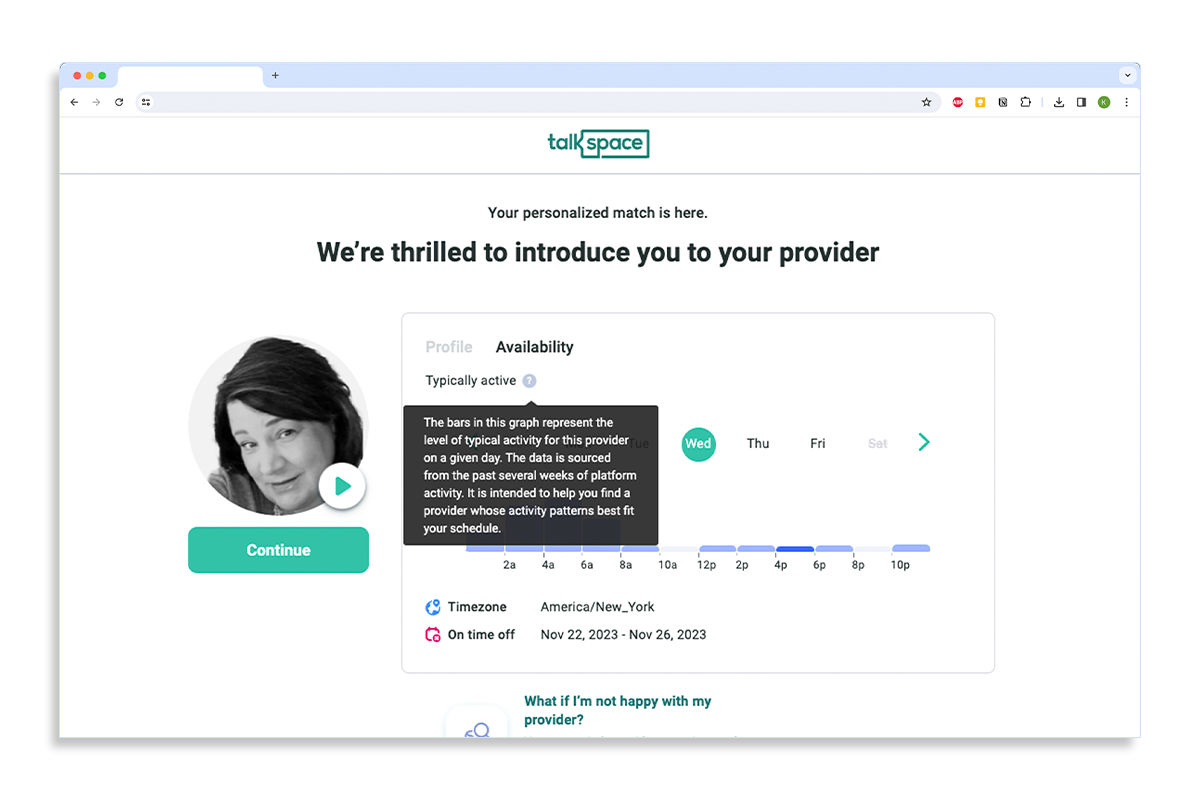
While the graph can be beneficial for choosing a therapist, we discovered it didn’t always align with the therapist’s actual availability. You may need to reach out directly to understand your provider’s schedule.
Additionally, Talkspace will notify you when your provider plans to be out of the office. These scheduling updates give you the chance to connect with your therapist beforehand to make a plan for how to take care of yourself while they’re out.
Detailed therapist profiles
If you decide to switch from your initial therapist match, you can view the profiles of the nine other providers Talkspace gave you when you first signed up. In addition to the availability graph, Talkspace provider profiles have short bios that include:
- Years of counseling experience.
- When they joined Talkspace.
- Their license.
- Upcoming scheduled time off.
- Areas of focus.
One of the most beneficial aspects of the profiles is each therapist’s video introduction stating their approach in their own words. Our tester found these videos helpful because it let them better understand their therapist’s tone, personality, and methodology.
Easily switch therapists
During our testing, we discovered many online therapy platforms like Calmerry and BetterHelp require you to contact customer service to switch therapists, and waiting for a response can interrupt the therapeutic process. Talkspace is one of the few platforms that allow you to switch providers without involving customer service.
Through the app, we could find a new match instantly from the nine provider profiles we were originally given. If you find none of the matches you received are suitable, you can contact customer service for help. However, once switching providers requires receiving new options from customer service, it can take a little more time.
When we contacted customer service for additional therapist options, it took one business day to receive a reply, and it required a lot of back-and-forth discussion. Ultimately, the conversation took place over an entire week.
What we don’t like
Technical difficulties during sessions
On more than one occasion, we encountered technical issues during our live sessions, which is a risk with any telehealth appointment. When our tester joined her first session from a browser, it would immediately kick her out. Luckily, once our tester joined from a mobile device, she could maintain the connection for the entirety of her session. Technical difficulties like these could create added stress for anyone trying to receive therapy, especially if they’re anxious about their first appointment.
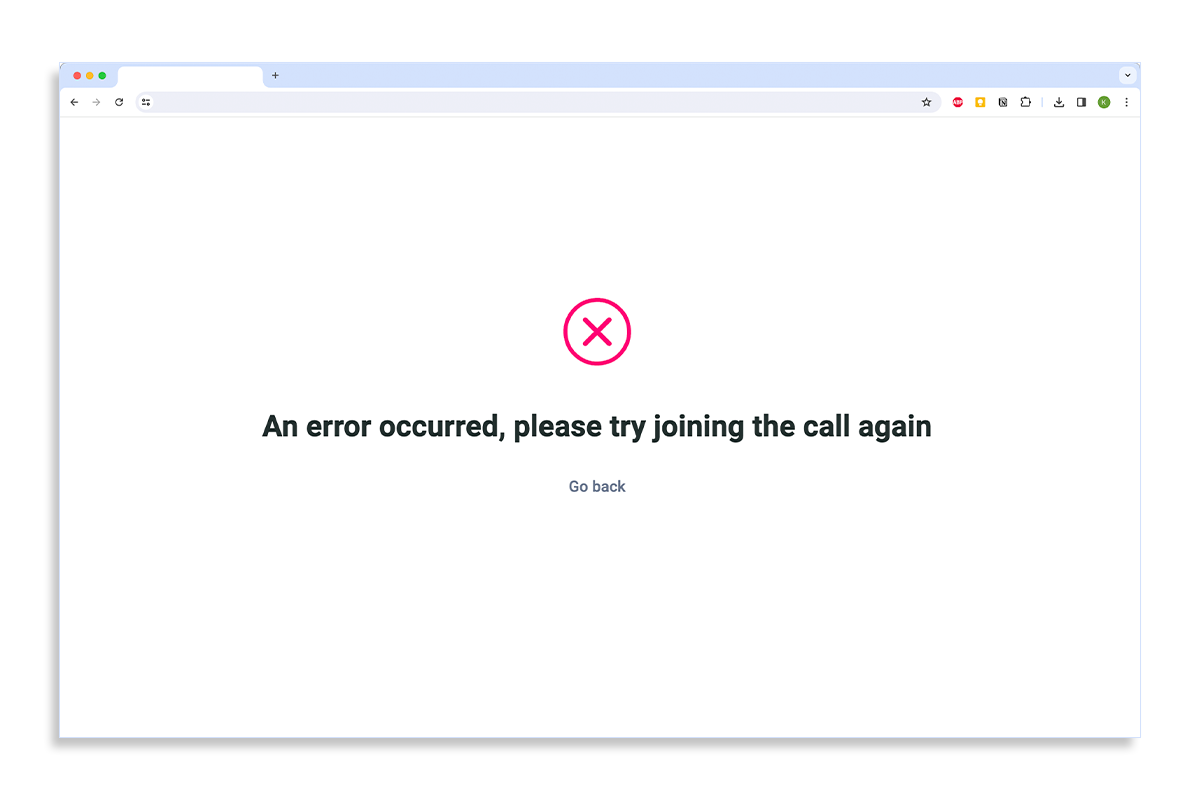
Another technical issue occurred during the tester’s live phone call session. She found the session would end abruptly when she locked her phone, interrupting her session multiple times.
From our tester
“One annoying thing I found was that when I closed my phone screen during the audio call, it would end the whole session for me, and I didn’t realize until I heard no response from the therapist. So I had to keep my phone screen on for the whole session, which was uncomfortable to hold the whole time (instead of putting it in my pocket or on the bench), and it drained a good chunk of my battery.”
Since it’s pretty common for someone to lock their phone while on a phone call, it may be beneficial for Talkspace to warn you.
Some therapists are unfamiliar with Talkspace’s features
We used three different therapists on the platform during our testing. Many of our matches were new to Talkspace and, as a result, were unfamiliar with many of the platform’s features. For instance, one therapist was unaware of the unlimited chat feature. Messaging is a big benefit of Talkspace, so having a provider who doesn’t use this feature can be disappointing. Our tester asked the therapist if she could message more, but he never followed through with the request.
One of the other therapists we matched with was confused by the “short-term” and “long-term” goals featured by the platform. These goals are shown in the app and help facilitate discussion around your progress. However, when our tester tried to discuss her goals with her therapist, he was confused and didn’t know what goals she was referring to.
From our tester
“I’ve done online therapy before, and one of the first things I ask my therapist is how I can use the app’s features to get the most out of my subscription and therapy sessions. I felt let down when I encountered more than one provider unfamiliar with the platform. Although I had already given them feedback about wanting to engage with more messaging, I wasn’t getting the support I expected from therapy on Talkspace. In the past, I used messaging to bring up items I wanted to discuss or learn more about, and found it helpful to sync and expand on these topics in the sessions.”
Although therapists aren’t required to use all of the features of Talkspace, therapists should be trained or knowledgeable about the app and its features. Otherwise, it can cause unnecessary friction between the therapist and the patient.
Limited provider preferences
When you match with a therapist through Talkspace, only two preferences are considered: the provider’s gender and the specific areas you want to focus on.
Areas of focus may include support for racial identity, stress at work or school, anxiety, eating disorders, or difficulty in relationships. You choose which area(s) you would like to focus on during sign-up, and that’s taken into consideration when matching you with a therapist.
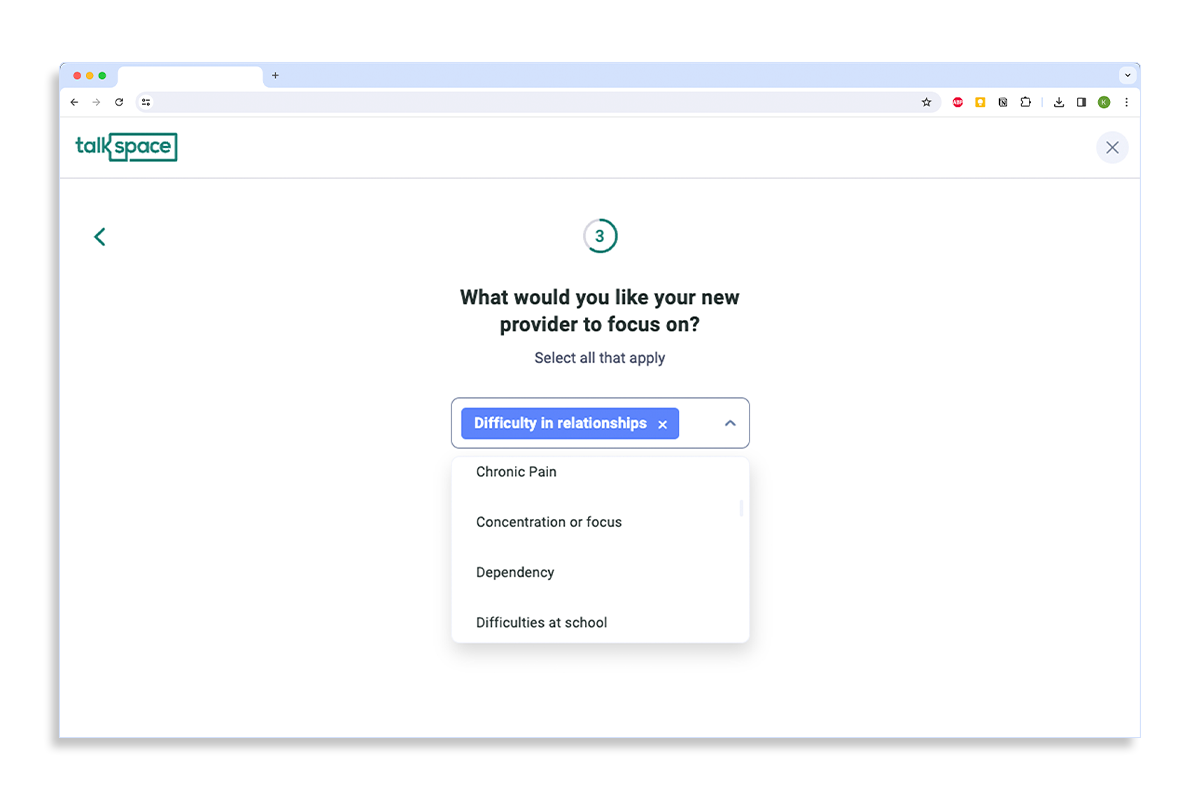
While the list of topics to focus on is extensive, your selection for provider preferences is limited to only male and female. Other platforms, like BetterHelp, consider other preferences like race, religion, and age. If you are interested in finding a provider with a shared identity, it may be difficult to do so through Talkspace.
What kind of online counseling does Talkspace offer?
Talkspace offers counseling for individuals, teens, and couples, as well as psychiatry for people seeking medication management for their mental health symptoms.
Individual therapy
Talkspace’s individual therapy provides personalized support for adults over the age of 18. You may consider individual therapy if you’re experiencing anxiety, depression, or other mental health disorders, life changes, relationship difficulties, stress, or any other concerns or issues. Individual counseling offers one-on-one support to address your personal challenges and needs.
Therapy for teens
Therapy can benefit all age groups, including teens. Talkspace for teens works similarly to individual therapy. The main difference is that the therapists have the experience and education to work with teens on their unique challenges and needs. Talkspace teen therapy is available for ages 13–17 with permission from a parent or guardian.
Teens who reside in New York City can access free mental health support through NYC Teenspace, a New York City Health Department program that provides therapy to teens aged 13–17 who live in the city. The program includes Talkspace’s Video + Messaging Therapy plan and the Talkspace Go app, which has interactive lessons and exercises. Teens can use this program until they turn 18. They will need their parent’s permission to sign up.
Couples therapy
In online couples therapy, you and your partner work with a licensed therapist to identify issues, resolve conflict, restore trust, and get the support you need. The couples therapy plan includes four 30-minute video sessions and unlimited messaging with your therapist. In addition to partners and spouses, couples therapy can include other two-person relationships such as parent/child, friends, or siblings. The person who initially signs up for Talkspace will be the primary account holder. The primary account holder can invite their partner of choice to join live sessions. While both parties attend sessions, the primary account holder is the only one who can change providers, schedule live sessions, check the clinical progress tracker, and respond to provider assessments.
Psychiatry
Online psychiatry can provide prescription medication management in addition to talk therapy. Through Talkspace, you will be matched with a licensed telehealth psychiatrist or a nurse practitioner, and you can change psychiatry providers at any time through the app. Some mental health conditions Talkspace psychiatrists treat include:
- Anxiety
- Depression
- Attention deficit hyperactivity disorder (ADHD)
- Bipolar disorder
- Insomnia
- Obsessive-compulsive disorder (OCD)
- Panic disorder
- Post-traumatic stress disorder (PTSD)
- Stress
Talkspace providers cannot prescribe stimulants (such as Adderall or Concerta), sedatives (like Xanax or Valium), or any controlled substances.
Data privacy concerns
When you sign up for any online therapy platform, you should take a careful look at its privacy policy. In 2022, Talkspace was cited by the American Civil Liberties Union (ACLU), a non-profit that flags online privacy issues, with concerns about how they use patient data.
Talkspace’s privacy policy states that they can use the information you submit during the sign-up process, like age, sexual orientation, gender identity, and mental health history, for marketing purposes. The policy also states that they can use that information for research and to create targeted user advertisements.
If you are a current Talkspace user with privacy concerns, you can email [email protected] stating that you don’t authorize them to use your information for these purposes. You can also request that they delete your data entirely if you no longer use the platform.
Key features of Talkspace
Here’s a breakdown of the standard features included with Talkspace.
How does Talkspace online therapy work?
During sign-up, you choose between three plans: Messaging, Video + Messaging, and Video + Messaging + Workshops.
Live sessions
A live therapy session is when you and your therapist schedule a time to meet on a video call, talk on the phone, or chat through the app. You can choose your preferred format and schedule through the website or app. If you choose a plan that includes live sessions, you get one per week.
You will receive a reminder in the chat room right before the appointment begins with a link to join. The session will start when both you and your provider are in the room.
Handbook Team Tip #1
During a live phone session, avoid locking your phone because it can cause the call to end abruptly, disrupting your session.
Unlimited messaging
With Talkspace, as well as most online therapy platforms, you don’t have to wait until your next session to talk to your therapist. Instead of jotting something down to remember for later, you can send them a message. Each of Talkspace’s therapists has a different schedule, so their response times will differ. When you’re matched with a therapist, ask when you can expect to hear from them.
Weekly workshops
One of the Talkspace plans includes weekly workshops. The workshops are teaching webinars that provide information on specific topics. Our tester found the workshops valuable and informative. There are webinars for individuals, groups, and couples. Some of the available workshops are:
- Exploring Your Relationship with Alcohol
- Practicing Emotional Regulation
- Balancing Work, Life, and Family
- Racial Trauma and Mental Health
- Coping with Loneliness
Most workshops are offered at 7 p.m. EST or later, so if you are usually not available after that time, purchasing the workshop plan may not be worth it.
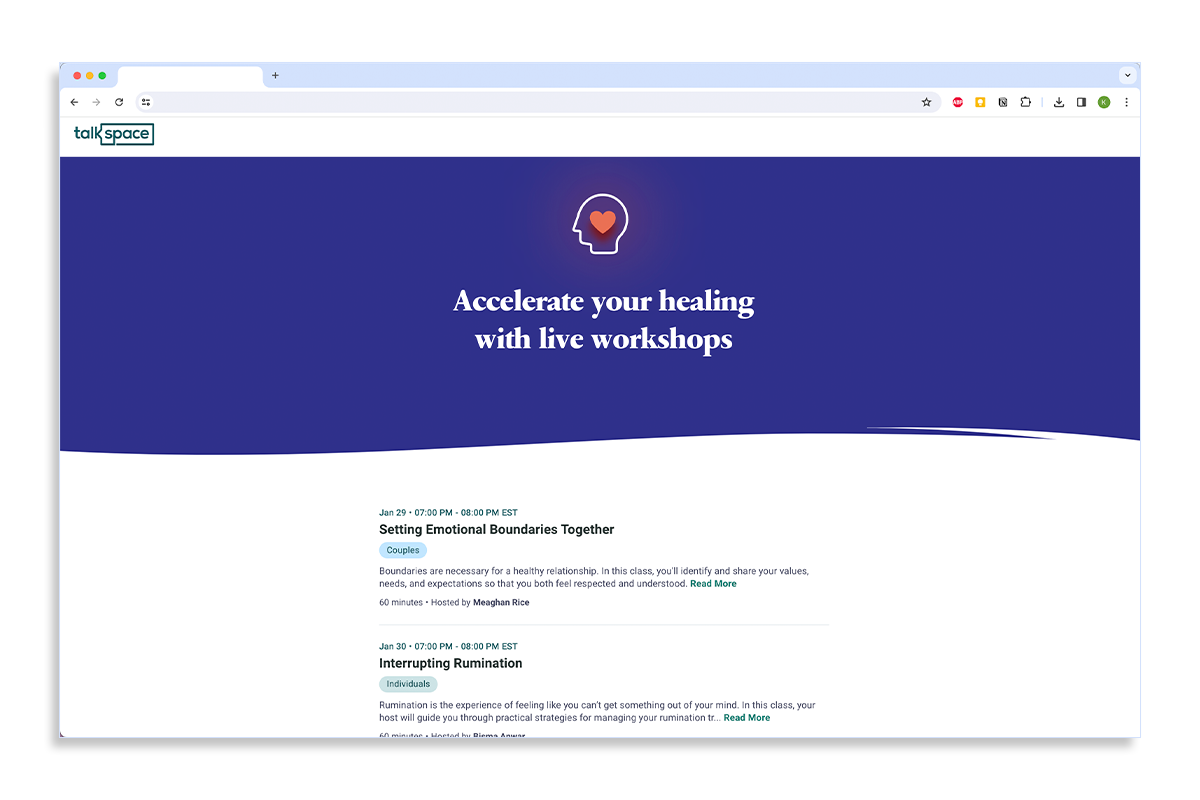
How much does Talkspace cost?
Of all the online therapy platforms we tested, Talkspace had the highest cost at $99 per session for its Video + Messaging plan. However, the cost will be lower if you use insurance. According to the website, most Talkspace users with insurance have an average copay of $30 per session.
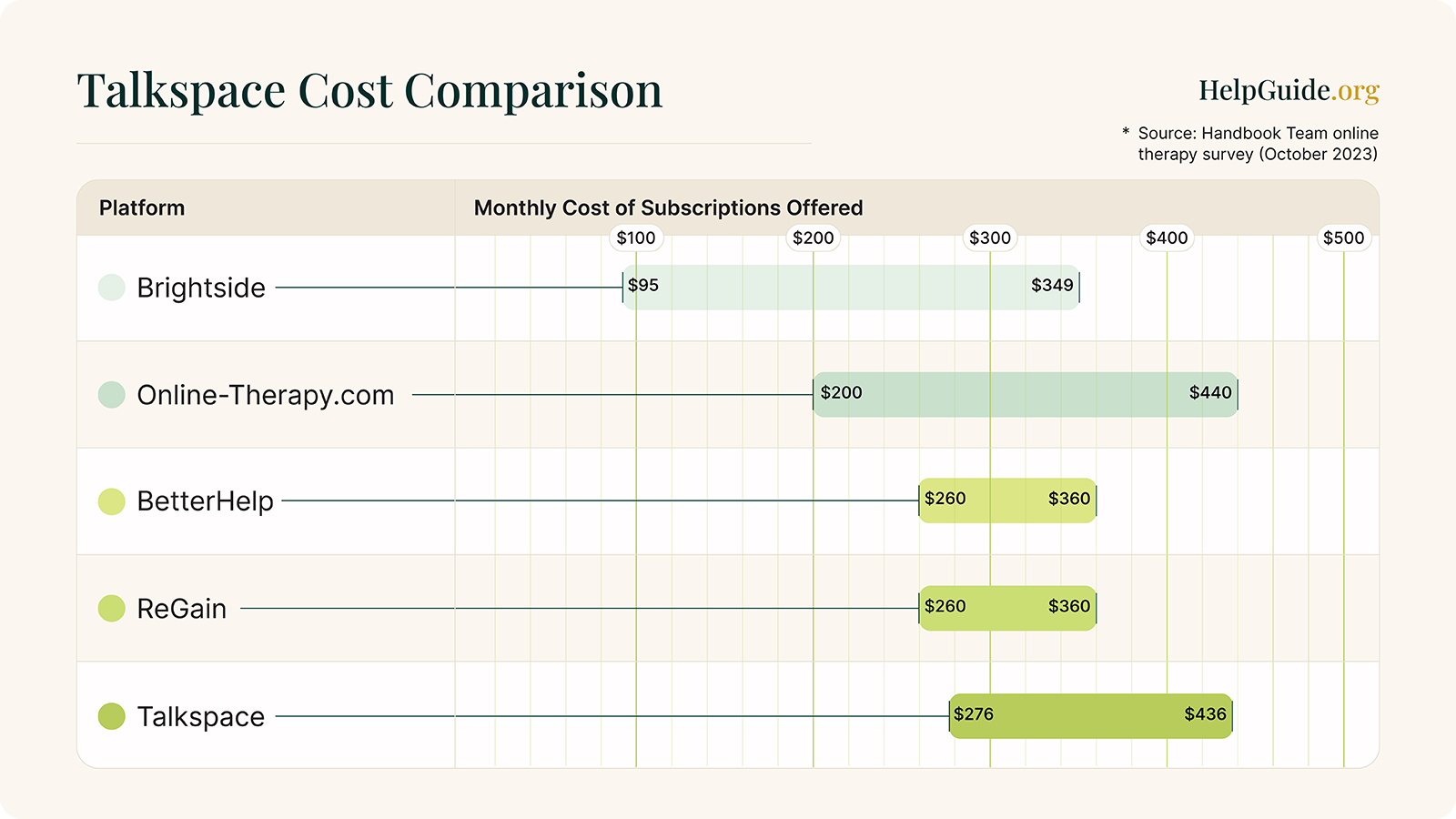
The cost of Talkspace will depend on the type of therapy you’re looking for and the session format you choose.
Cost of therapy
- Individual Therapy & Therapy for Teens (ages 13–17):
- Unlimited messaging: Starts at $276 per month.
- Four live video sessions and unlimited messaging: Starts at $396 per month.
- Four live video sessions, unlimited messaging, and weekly workshops: Starts at $436 per month.
- Couples Therapy:
- Four live video sessions and unlimited messaging: $436 per month.
Handbook Team Tip #2
If you’re considering the workshop plan, remember that most workshops are at 7 p.m. EST or later. If you aren’t available then, you may want to consider a different plan.
Cost of psychiatry
Talkspace also offers plans for psychiatry. Your plan will be based on whether you are a first-time or returning client.
For first-time clients:
- Initial psychiatric evaluation: $299.
- Initial psychiatric evaluation and one follow-up session: $435.
- Initial psychiatric evaluation and three follow-up sessions: $725.
For clients who have completed an initial session:
- Three follow-up sessions: $475.
- Six follow-up sessions: $890.
- Nine follow-up sessions: $1,260.
Does Talkspace take insurance?
According to our November 2023 survey, insurance is among the most important considerations for users deciding on an online therapy platform. Luckily, Talkspace is one of the few online therapy platforms accepting most major insurance plans, including:
- Aetna
- Cigna
- Cigna + Oscar
- Anthem
- Optum
Talkspace provides an extensive list of accepted insurance plans on its website. With insurance, your copay could be as low as $22 per session.
Is Talkspace covered by Medicare or Medicaid?
Unfortunately, Talkspace is not covered by Medicare or Medicaid. If you are interested in online therapy that accepts Medicare or Medicaid, we recommend Brightside as an alternative.
Does Talkspace offer financial aid?
Some college students may be eligible for discounted or free therapy through Talkspace. Students at the following universities may be eligible for discounted Talkspace services:
- Aims Community College
- Colby College
- Fort Peck Community College
- George Washington University
- Kishwaukee College
- McHenry County College one
- Roseman University of Health Sciences
- Swarthmore College
- University of Kentucky
- West Virginia University
- Williams College
You have to enter your college email address and a keyword provided by your university to sign up.
You can also use benefits through an Employee Assistance Program (EAP) to access Talkspace. An EAP allows you to attend a certain number of counseling sessions for free through your employer. If your company offers an EAP, you will need a valid authorization code and the approved number of sessions from your employer to sign up for Talkspace.
How to use the Talkspace app
The Talkspace app is available to download on the App Store and Google Play. Once downloaded, you will be prompted to select the type of therapy you’re looking for and fill out a brief questionnaire that will take five to 10 minutes to complete.
The questionnaire will ask about why you’re seeking therapy, questions about your physical and mental health, personal information, and your preferred gender for your provider. Afterward, you will choose a plan, answer a few more medical questions, and match with a therapist.
Our tester found the app very easy to use. She had no problem taking the assessments, managing her account, and switching therapists from the app.
Our final verdict
Insurance coverage can make online therapy more affordable, and Talkspace is one of the few teletherapy platforms that accepts it. With insurance, your copay could be as low as $22 per session. Without insurance, you may pay slightly more than other online therapy platforms, but the cost may still be worth it if you like Talkspace’s features.
Talkspace allows you to schedule a quick appointment with a provider that fits your schedule. The platform is transparent about provider availability, a feature often lacking in other platforms. It also allows you to easily change providers without contacting customer service, reducing the disruption to your care plan if you choose to switch.
Frequently asked questions
According to customer reviews, Talkspace has a reputation for providing quality therapists to users, with the caveat that there may be technical and billing issues, and they may use your data for marketing purposes.
The main difference between the two platforms is BetterHelp does not accept insurance or provide psychiatry services, both of which are available through Talkspace.
Talkspace therapy sessions are 30 minutes in length.
- Hilty, D. M., Ferrer, D. C., Parish, M. B., Johnston, B., Callahan, E. J., & Yellowlees, P. M. (2013). The Effectiveness of Telemental Health: A 2013 review. Telemedicine Journal and E-health, 19(6), 444–454. Link
- New York City Planning. (2022, July 1). Population Estimates for New York City and Boroughs as of July 1, 2022. New York City Government. Link
- New York State Education Department Office of the Professions. (2023, July 1). License Statistics for Psychology. Link




